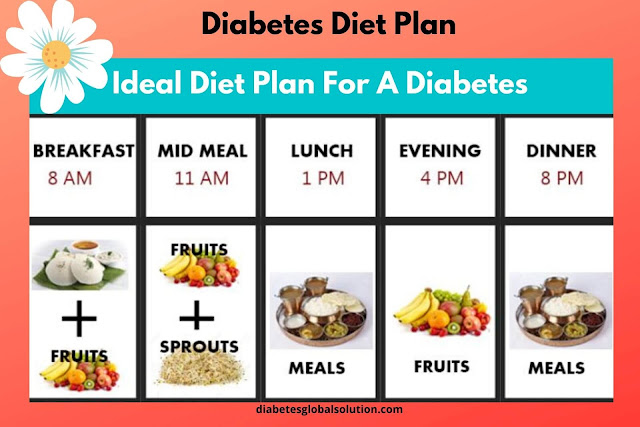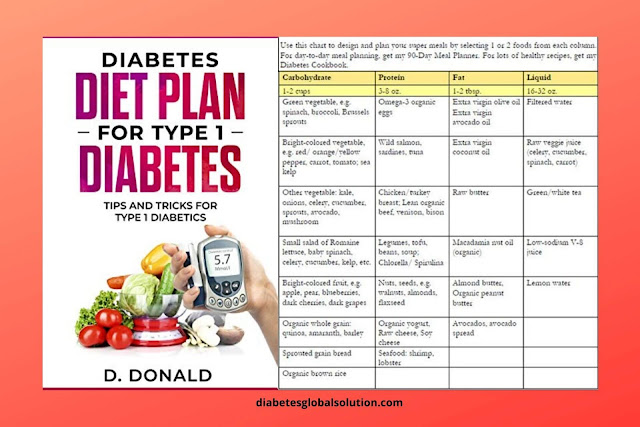A Diabetes Diet means having food that is healthy, in medium amounts. It
is a healthy eating plan that is rich in nutrients and low in calories. Key
food items in Diabetes Diet Plan are fruits, vegetables and whole grains, which
has various nutrients of vitamins and minerals to remain healthy and avoid
diabetes symptoms.
Diet
Implications
What
is the purpose of a non concentrated sweets/ Diabetic diet?
To accomplish and keep up
ideal blood glucose and lipid levels through suitable food decisions.
What
does the diet consist of?
The diabetic eating regimen
can differ from individual to individual contingent upon finding, current
wholesome status, blood glucose levels, glycated hemoglobin, blood lipids, and
circulatory strain.
In any case, it for the most
part comprises of observing the everyday admission of macro nutrients: starches,
protein, and fat. In particular, patients need to watch their sugar consumption
since it is the fundamental factor influencing postprandial blood glucose
levels.
What
are the nutritional recommendations of a diabetic diet?
The measure of sugar in the
eating routine is individualized dependent on the individual's standard
admission and wanted glucose and lipid objectives. Day by day admission of
starches can go from 45% to 60% of all out calories.
Blood glucose and insulin
reaction are impacted by both the source and measure of sugars expended. Of the
two, need is given to the aggregate sum of sugar devoured at every supper and
nibble instead of the wellspring of starch.
Protein admission should
comprise of 10% to 20% of the everyday calories. Dietary protein can be
acquired from vegetable and creature sources. Fat admission ought to be 25% to
30% of complete calories for the afternoon.
It is imperative to monitor your
lipid levels with your PCP. Cholesterol ought to be restricted to fewer than
300 mg daily.
How
can I make my prescribed diabetic diet work with the Meals on Wheels Regular
Diet plan?
Dinners on Wheels enrolled
dietitian invests heavily in obliging customers' needs and physical prosperity.
Every one of our dinners meets in any event 33% of the Daily Recommended
Dietary Allowance for guys 51+ years old.
For customers checking their
sugar admission, Meals on Wheels offers an uncommon eating regimen supper that
contains no concentrated desserts. By and large, contains less than 100 grams
of starches. Dinners on Wheels offer a solid treat that gives a low admission
of sugar, for example, an apple shoemaker.
On the menu you get, the
measure of calories and grams of starches per a course are recorded. This
permits you to monitor your calorie and starch admission.
Aside from my Meals on
Wheels food, what other heart- healthy foods can I consume for snacks and my
third meal of the day?
Vegetables
and starchy vegetables Recommendations:
3-5 servings per day
Enjoy all fresh, canned, frozen or cooked vegetables,
peas, corn, and potatoes
Grain
and Bread Recommendations:
6-11 servings a day
Appreciate unsweetened
wafers, for example, graham wafers, creature wafers, bread sticks, and
unsweetened bread.
Abstain from eating cinnamon
bread, improved or iced bread (doughnuts, espresso cake, cakes), glossed over
pre-improved grains, nectar or natural product seasoned oats, and granola oats.
Fruit
Recommendations:
2-4 servings per day
Appreciate new or solidified
natural products prepared without sugar, water-stuffed canned organic products,
and unsweetened juices
Limit canned, new or solidified natural product with
sugar included.
Dairy
and Milk Recommendations:
2-3 servings a day
Appreciate skim or low fat
milk, all cheeses, and plain low fat yogurt (improve with new natural product
or cinnamon).
Limit seasoned yogurt,
solidified milkshake, and enhanced milk (for example chocolate, strawberry),
improved coco blends, and eggnog.
Snack
and Fat Recommendations:
Utilize sparingly day by day
Monounsaturated and polyunsaturated fats are favored fats
and oils.
Appreciate however limit
margarine or spread, sugar free gelatin dessert, sugar free custard, fluffy
cake, vanilla wafers, gingersnap treats, and popcorn.
Maintain a strategic
distance from Frozen whipped garnishes, for example, "Cool Whip",
frozen yogurt, sherbet, sorbet, organic product ice, iced cakes, cupcakes, pie,
puddings, baked goods, caramelized popcorn, and breakfast bars.
Here are the significant
diabetic eating routine dinner plan techniques that you can use to figure out
what and the amount you eat:
- Plate Method
- Table Method
- Carb Counting
- Glycemic Index
- Trade Lists
Every one of these
techniques can be utilized to help your to lower and control your glucose.
Note: For thoughts and tips
on diabetic feast arranging, visit our Diabetic Meal Planning website page.
The
Plate Method
This strategy for supper
arranging use the utilization of pictures and obvious prompts to assist you with
structuring sound dinners.
As appeared in the image
(underneath), separate your plate into equal parts. On the second 50% of the
plate isolates it into equal parts.
Thus, your plate will have
three areas - one enormous segment and two little segments.
A 1998 article in the
Journal of the American Dietetic Association revealed that dietitians from
Canada, Finland, France, and Sweden concurred that the Plate Model gave
numerous advantages including:
Improvement is the
association between dietary hypothesis and practice.
Advancement is memory
maintenance and comprehension through visual messages.
Experience is a positive way
to deal with nourishment guiding.
Different cooking styles and
merry nourishments can be fused into the model.
The model offers a supper
arranging approach that is straightforward and adaptable.
Low-glycemic, non-bland
vegetables incorporate broccoli, Brussels fledglings, kale, and spinach. Use
chime peppers, onions, and garlic for preparing and cancer prevention agent
support.
Lean protein nourishments
incorporate poultry (skinless), wild fish, wild game, natural eggs, nuts and
seeds.
For the other little area of
the plate, incorporate beans, mushrooms, natural earthy colored rice, a natural
entire grain, or more vegetables.
The plate technique is the
favored dinner plan strategy utilized for our converse diabetes diet.
Be that as it may, on the
off chance that you like, you can in any case use carb checking, calorie
tallying or some other technique.
Diabetic
Meal Plan Table Method
This strategy utilizes a
table graph with a section for each major macronutrient - as appeared in the
outline underneath.
You just select a
significant food from every segment to structure your diabetic dinner.
For instance, for the
Carbohydrate segment, you select a green vegetable from the principal line;
and, include 1 extra line (for beans, an entire grain, or more vegetables).
For the Protein section,
select one of the columns, for example, eggs from the principal line, wild
salmon from the subsequent line or chicken or turkey from the third line.
For the Fat segment, select
the primary line for additional virgin olive oil or avocado oi; or, select the
second column for additional virgin coconut oil.
Carb
Counting
This diabetic dinner plan
strategy is centered around tallying starches since this macro nutrient has the
greatest effect on your glucose.
In this way, following what
number of carbs you eat encourages you to keep your glucose inside your typical
range.
All in all, most diabetics
should target 50 to 70 grams of carbs per supper as long as they are adjusted
against the measure of protein and fats. In any case, this number will differ
contingent upon your medical problems, your meds, your weight, and your
movement level.
Your primary care physician,
nutritionist or diabetes wellbeing mentor can reveal to you what number of
carbs you need every day and how to spread them out to forestall glucose
swings. A great many people with diabetes should focus on 45 to 60 grams for
each feast.
As a general guide, utilize
a dietary food outline and part control to decide the amount of every food to
put on your plate. For instance, a portion of cup of beans or a little apple
contains around 15 grams of carbs.
The
Glycemic Index
The Glycemic Index (GI) is
an estimation (on a scale from 1 to 100) of how quick a particular food is
assimilated and raises your glucose. The higher the number, the quicker that
particular food is assimilated and raises your glucose.
For instance, starches with
a low GI esteem (55 or less) are all the more gradually processed, assimilated
and utilized and cause a lower and more slow ascent in your glucose.
Be that as it may, starches
with a high GI esteem (at least 70) are processed, retained and utilized
rapidly and cause a higher ascent in your glucose.
Low glycemic nourishments
incorporate non-dull vegetables, beans, lentils and some entire grains.
High glycemic nourishments
incorporate white rice, bread, baked goods, and pop.
Much of the time, the
glycemic file works best when utilized related to carb tallying or a low
glycemic diet.
Exchange
System
The Exchange System bunches
together nourishments that have generally similar measures of calories, sugar,
fat and protein into "Trade" gatherings, with the goal that one might
be traded for another.
For instance, one vegetable
trade might be either some crude spinach, a half-cup of cooked asparagus, or a
half-cup of tomato juice. One starch trade incorporates a cut of bread or a
half-cup of cooked pasta.
There are six principle
classes of nourishments:
- Vegetables
- Natural product
- Starch/Bread
- Meat and Meat Substitutes
- Milk
- Fat
Each trade compares to a
fixed serving size: one trade in the "Starch/Bread" gathering, for
example, could be a 6-inch corn tortilla or 1/2 cup of green peas or 1/3 cup of
pasta; a trade in the "Lean Meats" gathering could be an ounce of
fish or lean pork.
Your nutritionist or
dietitian will work with you to plan out your daily meal pattern including
which exchanges to include in each meal from each food group and how many.
Their exchange list strategy
will help you to keep your blood sugar levels consistent from day to day.
During our diabetes training
classes, many diabetics expressed concerns about portion control for three
reasons:
Some diabetics didn't
understand how to measure their food portions properly.
Some diabetics struggled
with tracking their caloric intake and/or their carbohydrate intake.
Some diabetics had food
cravings that caused them to overeat and disregard portion control.
In all three scenarios,
diabetics found themselves facing higher blood sugar levels, weight gain, and
increases in blood pressure, as well as chronic fatigue issues.
Benefits
of Portion Control
Keeping to reasonable part
sizes will help in overseeing calorie admission and this likewise has benefits
for blood glucose control.
A Japanese report
distributed in 2009 recommends that the related insulin obstruction develops in
direct extent to a growing waistline.
So keeping segment sizes
moderate can help monitor calorie admission, helping you to deal with your
weight and consequently making diabetes simpler to control too.
Overseeing segment sizes is
likewise a significant piece of dealing with the measure of sugars you devour.
Having a decent handle of
segment sizes is required so as to have the option to tally sugar admission to
guarantee that you are not taking in more starch than your body can adapt to.
Here are a few thoughts and
tips that will assist you with your part control and keep your glucose in the
ordinary range.
Utilize Your Hands and Other
Visual Aids to Measure Your Portions
One of the more helpful
approaches to gauge your food parcels is to utilize your hands and fingers to
quantify food partitions.
For Example:
A 3-ounce serving of meat or
fish is the size of your open palm and the thickness of your little finger.
A serving of entire grains,
starches or organic product is about the size of your shut clench hand.
An ounce of meat or cheddar
is the length of your thumb (tip to base)
1–2 ounces of nuts is the
size of your measured hand.
1 tablespoon is equivalent
to the length of your thumb (tip to first joint).
1 teaspoon is equivalent to
the length of at the tip of your finger (tip to first joint).
Another approach to quantify
food parts and gauge serving sizes is to recognizable articles like a deck of
cards, a baseball or a tennis ball.
For Example:
One cup is about the size of
a baseball.
A half cup is about the size
of a tennis ball, which is equivalent to 1 oz reciprocals, for example, one
serving of grains like cooked pasta, cooked rice, or cooked oats.
One 3-ounce serving of meat
is about the size of a deck of playing a game of cards.
Utilize
Smaller Plates to Control Food Portions
Utilizing littler plates is
another approach to control your food partitions. Another alternative is to
utilize a serving of mixed greens plate rather than a supper plate.
At the point when you
utilize a littler plate, your cerebrum imagines that you should fill the plate
with food. On the off chance that you utilize a littler plate and spread the
plate in food, you'll naturally eat less food.
Like utilizing littler
plates is utilizing the plate strategy. Take your plate and partition it down
the middle. One-portion of the plate ought to be loaded up with vegetables.
The
other half isolated again into quarters, one loaded up with a protein and the
other quarter loaded up with a little segment of vegetables, grains or more
vegetables.
Keep a Food Journal to
Monitor Your Food Portions and Blood Sugar Levels
Since we're so occupied with
during the day, it's anything but difficult to overlook the amount we've eaten
or to disregard each one of those little bites that we ate in the middle of dinners.
In this way, utilize a food
diary to follow your glucose readings, what you're eating, and the amount
you're eating.
Most occasions individuals
are shocked to perceive how much food they eat each day, and it can assist with
controlling segments.
Additionally, as long as you
can manage the cost of the additional test strips, measure your glucose before
you eat and two hours after you eat; and, incorporate what and the amount
you're eating.
FYI: An examination
distributed in the diary Obesity (February 2019) found that the recurrence of
dietary self‐monitoring
essentially assists with weight reduction.
Utilize
a Food Scale for Portion Control
Perhaps the most ideal
approaches to control your segment sizes is to gauge your food utilizing a
scale. Measuring your food will tell you precisely how much food you're eating.
This removes the mystery from parcel control.
For certain individuals,
this may appear pointless excess, yet in case you're diabetic, it assists with
understanding the quantity of carbs you're eating.
A food scale is significant
for diabetics that are looking to deliberately deal with their diabetes. When
you utilize the food scale for some time, in the long run you'll have the
option to skirt the scale and have the option to make taught surmises on the
measure of food you're eating.
Follow
a Good Diet to Help with Portion Control
In all honesty, probably the
most ideal approaches to keep your glucose levels in a sound range is with a
decent low-glycemic, mitigating diet.
Beside eating a lot of
vegetables and avoiding the bread and desserts, partition control is an
incredible procedure for remaining solid and dealing with your diabetes.







Post a Comment